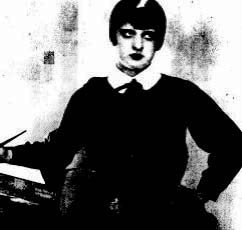
My latest Visual Poetic project entails a mixture of automatic writing and drawing. The project cover a week. Each day is treated artistically the same: at the end of the day a word surfaces above all others (which, later, becomes the title of the installment), automatic writing ensues at breath, which is then mixed with drawing, materials are laid before hand and anything may be used. The finished work is then displayed like a weekly calender and is offset by extricated text found within the automatic writing. Inspiration? Alistair Brotchie's The Book of Surrealist Games edited by Mel Gooding.
Dedicated to The Muse of Automatic Writing-
With Love,
The Cat Woman

The Muse of Automatic
WritingHer Use in Therapy
Automatic writing is used as a tool in Freudian
psychology and in related "self-knowledge" studies, where it is seen as a means
of gaining insight into the mind of the automatic writer through their
subconscious word choices.
It was primarily used by Pierre Janet in France,
and later by Morton Prince and by Anita Mühl in the United States.
Her Use in Stimulating
CreativityThe ideas of Hélène Smith influenced the Surrealist
movement. André Breton, leader of the Surrealist movement, pioneered its use
within the movement and produced several important pieces of automatic writing,
most famously Soluble Fish. The Surrealists dubbed her "The Muse of Automatic
Writing"; in the Surrealist deck of cards, Smith is the "Genius of Knowledge."
Automatic writing became a part of the Surrealist's repertoire of games, and it
soon developed into a number of other Surrealist games and tools that greatly
influenced the movement, such as automatic drawing, automatic palimpsest, and a
variety of marker-word games.
Free writing later gained popularity with
writers and poets, both as a means of stimulating creative thought and as a
technique for overcoming writer's block.
Her Criticism
Skeptics point out that automatic writing claimed to be of
supernatural origins is a parlor game that has little more effect than to spark
creativity in the minds of the participants. They claim, as with other
paranormal phenomena, that the subconscious of those performing the writing is
the only thing influencing their actions and that there is no solid evidence
that any messages are coming from anywhere other than the minds of the person
holding the pencil. This is referred to as the ideomotor effect.
As there is
no scientific evidence supporting the use of automatic writing in therapy, its
usage to release repressed memories is suspect as well. While unconscious ideas
are expressed in automatic writing, skeptics point out that it is unlikely that
they are any more profound than the writer's conscious thoughts. Skeptics argue
that there is no evidence that the "true self" lies in the unconscious any more
than it does in normal consciousness.
-from http://www.autowriting.com/ © 2005

0 Comments:
Post a Comment
<< Home